Newsletter
Current
Previous
|
April 2023
|
|
|
|
|
Wild Isles, the latest series of wildlife programmes on BBC One to be presented by David Attenborough, has been much in the news recently. Described on iPlayer as “Extraordinary. Dramatic. Beautiful”, and filmed in 200 shoots over three years, it “celebrates the wonders if British wildlife … as you’ve never seen it before”. I expect we don’t need much persuading. But in addition to the five episodes of the series, there is a standalone documentary – Our Precious Isles – which addresses the threats our landscape and its wildlife face. Controversial it might have been, when the Guardian claimed (in error, it now seems) that it had been side-lined by the BBC and relegated to online delivery, but it addresses an important issue. There is little point in celebrating our natural environment if it is to disappear. It behoves us all to value and help conserve, and hopefully the Earley Environmental Group is making a positive contribution locally, through education, planning policy and practical conservation, as you’ll see on the following pages.
Edwin A.R. Trout
|
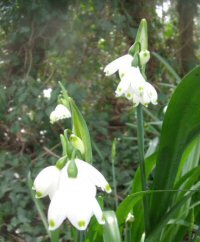
The Loddon Lily (photo: Edwin Trout)
|
Toad Patrol - see report below

Berkshire’s Flower: the Loddon Lily
Also known as the Summer Snowflake, the Loddon Lily or Leucojum aestivum is the county flower of Berkshire, nationally rare, but long-established in the vicinity of the River Loddon. There are examples in Maiden Erlegh’s Oak Wood, coming into bloom between February and April. This year, the first were out by 12 March.
|
|
Committee News
Announcements from the AGM and latest committee meeting.
The Committee 2023-2024
After last year’s virtual AGM, the 2023 meeting was held in person. Chairman Bob Collis reviewed the year’s activities, Hon. Treasurer Jeremy Jones reported a positive bank balance and Liz Wild stable membership numbers. The committee was re- elected en bloc. Stewart Macleod kindly took the minutes.
Bob Collis – Chair
Grahame Hawker – Vice-Chair
Jeremy Jones – Hon. Treasurer
Liz Wild – membership
Charlotte Allchin – programme
Brian Hackett – website
Edwin Trout – newsletter
Anne Booth
Alan Broodbank
Elaine Butler
Sheila Crowson
The Group arranged to be represented at WBC’s Air Quality Steering Group meeting on 17th March.
Bob Collis was the Group’s nominated speaker at the ETC Annual Electors’ Meeting on 21st March.
Snippet
Alien species of plant overtake native British varieties
There are now more alien species of plant in Britain than native varieties, half of which are in decline. There are 1,753 non-native species compared with 1,692 native ones, according to a study by the Botanical Society of Britain & Ireland.
[Metro, 9 March 2023]
|
EEG’s 2024 Community Calendar
– photographs wanted
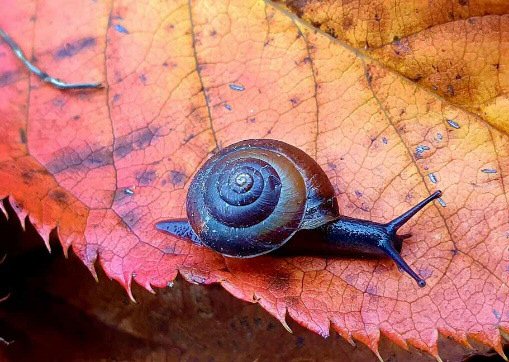
It’s time to start thinking about submitting photographs for the EEG’s fifth calendar. The previous four have been a great success, contributing over £1,000 towards the EEG’s work in helping to protect and preserve the local green environment.
We are grateful to the many photographers who have submitted photographs in the past. The 2023 edition featured 40 photographs from 19 photographers; the snail on the autumn leaf taken by Steve Prior (above) features on the November page.
We welcome images that capture Earley’s natural environment, including images of Maiden Erlegh Nature Reserve, our local parks and meadows and the natural world found in our own gardens. Photos of woodland and lake scenes, wildflower beds and walkways, as well as pictures of Earley’s birds, animals, trees, flowers, fungi and insects will be welcome.
The copyright of all selected images would remain with the photographer, but by providing the image for the calendar, the photographer would grant a perpetual licence to the EEG to feature the image in any of its publications. All images used will be credited to the photographer.
Thank you to all who have bought the calendars and to those who have sold them on our behalf; the Earley Town Council Help Shop, St Nicolas Parish Church, the Huntley and Palmer Allotment Association and FAD at Silverdale Parade. The 2024 calendar will be available on Saturday 5th August at the Earley Green Fair, and will then be available at other locations and through the EEG’s email address below.
The deadline for submission of images is the Sunday 18th June 2023. Photographs should ideally be submitted in JPEG format and no larger than 5MB in file-size. Please send your photos with your name, image titles and contact email address to me at: EEGphotocalendar@earleyenvironmentalgroup.co.uk
Bob Collis, Calendar Editor
|
|
|
|
Planning Matters
A round-up of developments that affect the land use and planning status of space in our area.
Green Corridors
The February meeting saw the presentation of the EEG’s proposals for establishing green corridors in Earley, currently with WBC and enjoying the support of Earley Town Council. Bob introduced the idea of green corridors, explaining the concept as a means of overcoming habitat fragmentation, developed in detail in the Governmentcommissioned Lawton Report. The report aimed to identify ways of restoring habitats and providing accessible natural environment, improving the quality of green space, increasing the size and number of sites and reducing the pressure on them. Key to this is the establishment of designated sites, buffer zones, ‘stepping stones’ and links within and between connected green corridors. Applying this concept to Earley, Bob explained that the Group had already nominated 12 local green spaces in WBC’s recent consultation, contributed to the campaign to protect Swallows Meadow, and proposed the designation of a Lower Earley LNR. The proposal of corridors would link these together. Pointing to a map, a provisional draft of which appeared in Newsletter No.61, Bob described four green corridors along the Loddon, the Thames, Maiden Erlegh and between Whiteknights and Bulmershe. These were supplemented by three transport corridors – the M4 and Earley’s two railway lines – and importantly, were linked to the adjacent districts. He hoped that with local authority support, the designation of corridors would inform planning policy, offer protection and guide environmental management.
|
Laurel Park 3G Pitch: Threat Returns
Bob Collis

We thought it was all over – but it isn’t now! It’s just over a year ago since the EEG, together with MERA and local residents’ group MBOS, held a rally at Laurel Park to hear residents' views on Wokingham Borough Council’s proposal to build a 3G pitch on the playing field next to Maiden Erlegh Local Nature Reserve. The EEG had written to councillors asking for the proposal to be dropped because of the adverse impact on the nature reserve and loss of local green space. Shortly before the rally, however, the then Leader of Wokingham Borough Council wrote that “A review of a 3G pitch at Laurel Park indicates that this site is not suitable and therefore will not be progressed by this administration”. A reprieve for Laurel Park?
Since then, a new 3G pitch has been proposed for the playing field at Maiden Erlegh School, for which a public consultation was held at the school in September last year. At the time, the council estimated that the pitch would be constructed during the summer of 2023. The EEG raised its concerns over the impact of the pitch on the natural environment and wrote requesting to see a detailed design and detailed assessments of the demand for a new 3G pitch in Earley, as well as of alternative sites, of potential pollutants from the pitch structure and also the impact of traffic, noise and lighting on Buckhurst Copse and adjacent properties. Would we be seeing construction traffic at Maiden Erlegh School this summer?
To our surprise, Wokingham Borough Council announced in its January 2023 Roundup Newsletter that that its “executive will consider plans to cease further work on a proposed 3G sports pitch at Maiden Erlegh School”. It goes on to state: “Our financial position has worsened and costs for this project have escalated since last summer when it was first agreed to consult on these proposals. If agreed, work on the proposed 3G sports pitch at Maiden Erlegh School in Earley will stop while we develop a Playing Pitch Strategy. Part of this strategy will reassess the needs of Earley and Lower Earley and identify key sites suitable for future 3G sports pitch provisions in the borough”.
We understand that the strategy is to be competed in the summer of 2023, and that a full evaluation of 3G pitch provision will then take place. The strategy will assess the supply and demand of playing pitches across Wokingham Borough and recommend strategic priorities for sport pitches to meet the demand from local clubs and organisations now and in the future. These will include major new communities, such as those at Arborfield Green and the Shinfield area, and school sites which have existing playing pitches.
So, definitely no reprieve for Laurel Park and, for the time being, no construction traffic at Maiden Erlegh School, as both locations will presumably be thrown into the mix with all other possibilities while the council’s Playing Pitch Strategy is developed. We will await the publication of the strategy and hope that preserving the natural environment, its wildlife habitats and valued green recreational spaces are given the highest of priorities when the council considers its options.
|
|
EEG Talks
Reports of talks given at recent EEG meetings, starting with guest speaker, George McGavin.
In introducing Dr McGavin, EEG’s Alan Broodbank recalled his early days at Imperial College’s Silwood Park, as he paid tribute to George’s dedication and his boundless and infectious enthusiasm. But in time George moved on to Oxford, where he became a lecturer for the next 30 years and since has done more than anyone to draw the attention of the world to the importance of insects, through his numerous books and televised expeditions to New Guinea, Thailand, Belize and Tanzania. Responding, George described the evening as a trial run; next year he’d be on tour, giving his talk at ten venues – and being paid a lot more!
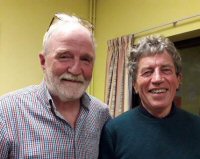
Dr McGavin (left) with Alan Broodbank
Photo: Elizabeth Trout
Bumblebees
Bumblebees learn by watching their peers, a study shows. Bees that learned to open a puzzle box to get a sugar reward passed their knowledge on to others in their colony, with ‘observer’’ bees cracking the code more often, scientists at Queen Mary University of London has found.
[Metro, 8 March 2023]
Talks
Reports of talks given at recent EEG meetings.
Net Zero in Industry
Edwin Trout spoke at the AGM to review the various strategies adopted by heavy industry – steel, aluminium, electricity generation, brick-making, and particularly cement – to achieving, or even exceeding, ‘net carbon zero’ carbon emissions. If interested, more details are available from Edwin Trout.
Children & Nature
Citing a survey in which 87% of respondents claimed Nature made them happy, and referring to the opposite concept of a Nature Deficit, Charlotte Allchin explored the interaction of people and the natural environment. She moved from Mike Richards’ proposition, “Nature contact is good for human beings” to his “Nature connection is good for people and nature”. She illustrated this with the work of the Earley Elfins (aimed at children up to the age of 8, but involving parents and grandparents), and that of the Earley Oaks (a group of older people, but who help in bringing children back to the reserve). She described the annual bat walk and the moth evening, and possibly the highlight for children, the Broodbank Bug Hunt. She imagined over 200 children had attended over the years. Alan Broodbank added that he had been approached by a tall young man only a couple of weeks previously, who asked if Alan was “the bugs man”. He’d been to the bug hunt as a youngster, and recalled it with pleasure. Alan took that as a gratifying measure of impact.
|
All Creatures Small and Great:
How Insects Make the World
A talk by Dr George McGavin, 16 Nov 2022
He opened by confiding he wasn’t top of the class in his native Edinburgh, but he did like biology. He was affected by a stammer as a child and allowed his attention to be distracted by flies, with whom there was no need to speak. At school, he submitted a survey that won him a prize, but – as he self-deprecatingly confessed – nobody else had handed anything in. He went on to read Zoology, and attained a PhD in Natural History.
The start to his career was, as he described it, a fluke. A chance phone call by the careers service landed him a role studying Myrie bugs with the distinguished entomologist Sir Richard Southwood. Then in 1978 he moved to Silwood Park for five years. But it was at Oxford that he spent the longest stretch of his career. He was based at the Natural History Museum, which has second-largest insect collection in the UK. Eventually, however, he realized he was preaching to the converted and abruptly resigned to do TV work (without even checking the pension arrangements!). This would allow him to share his passion for the natural world, and especially insects.
The BBC filmed five expeditions, each following a similar format: unscripted, with 35 scientists participating and lasting six weeks: “I loved it”. George’s role was to identify insects on the hoof and come up with interesting facts to camera. Not everyone can do that, George suggested. He recalled an occasion when two American presenters on a boat caught sight of something in the water behind them and one of them declared breathlessly, “I think it’s a fish”. George’s comment: “Come on guys, surely you can do better than that!”
How many species?
Turning to his subject proper, George set insects in a broader context. Plants, algae and fungi represent 25% of species in the world, and vertebrates only 2.9%. Invertebrates, however, account for 77%, of which the vast majority are insects. 1 million have been described by science, maybe 14% of an estimated total, yet we pay them little attention. He showed us a montage of images from across the wildlife spectrum and claimed he just knew we were drawn to the cute bush baby! Some audiences even say “ah” at this point, he said.
The importance of insects
The 8bn insects make the world work, George stressed, though he could make an exception for head lice; there would be no ill effect from their loss, apart for the impact on shampoo sales! Why are insects important? Simply, they provide essential ecosystem services: pollination; predation; recycling; food for other species.
Pollination
This role evolved 100m years ago with the emergence of flowering plants; using insects is more efficient than relying on the wind. And today 75% of the world’s 80 major crops are dependent on it. Without pollination there would be no chocolate: “oh, yes, we love insects now!” Bees are the most obvious example of pollinators. There are 20,000 species of bee, of which the UK has 257. Einstein is said to have commented that without bees we’d have four years left. There is no evidence of this remark and George reckons it might be five to ten years, but the point is still made. In Hanyuan, China, they now rely on hand-pollinating pear trees. Indeed, robots are currently being developed to undertake the task of pollination.
Predation
Insects are usually herbivorous and 80% of insects are eaten by other species, or by the minority of predatory insects. George cited the Parasitic Wasp, whose mode of existence caused Darwin to doubt God. This wasp is ingenious: to keep its host alive, it doesn’t eat the essentials, just the fat tissue. Then at a key moment, it switches and eats its way out (like in the film Alien). Although we see the process, we don’t know what causes the switch.
He gave two more, equally unappealing examples of insects relying on other species for food: Bed bugs – about which he offered an amusing anecdote in which he was given six bottles of wine to keep quiet about bed bugs in an Antipodean hotel – and mosquitoes, the medium for transmitting malaria.
Recycling
Two examples graphically illustrated this theme. The first was the ability of insects to consume and recycle carcasses. George ran some video of a frozen rat thawing out and rotting over eight weeks, and 24 fat beetles found in the controlled environment of the experiment tank. Dung was the other. Dung is generated at a rate of 100bn kg/day – the equivalent of the daily flow of water over Victoria Falls – and would linger for months if not for insects. The Great Plains of Africa, with their enormous herds of herbivores, only work as an ecosystem because beetles clear the dung.
Food for other species
Insects weigh 25% of the animal biomass, and provide a major food source for other animals. Bats (except fruit bats) are entirely reliant on insects, as are anteaters, aardvarks etc. George wondered how many insects are eaten to transform hatchling Great Tits to fledglings; he suggested it might be in the order of c120,000 insects.
The One Show
An invitation to join The One Show in 2002 was an unexpected turn in George’s career. Over a 15-year period he made nearly 100 short films on the subject of nature from around the UK. He showed us one, filmed on one of the Scottish isles, about the Great Yellow Bumblebee. This formerly widespread bee has suffered an 80% loss in range due largely to the loss of wildflowers in grassland, and can now be found only on Orkney and Shetland.
Shifting base-line syndrome
Turning to a more sombre tone, George introduced the ‘shifting base-line syndrome’, arguing that we adjust to gradual deterioration each and every year. He contrasted images of Constable’s The Hay Wain, painted in 1821, with the same scene in 2022. Nature is being depleted, he warned, and he concluded his talk with a brief review of the major issues of habitat loss, pollution, invasive species, over-exploitation and the over-arching ‘Climate Change’. George confessed he was pessimistic. Two phrases drive him spare: “sustainable growth” and “save the planet”. The question should be, he contended: “How are we going to save ourselves”. It was a sobering conclusion to an entertaining and at times ebulliently presented address.
Report by Edwin Trout
On the night, audience donations raised £241 for George’s chosen charity.
|
|
Words & Pictures
Bob reports on the recent photograph exhibition and Edwin shares a recent book review.
Winter Photography Exhibition a Success
Bob Collis
The EEG held its ‘Winter’ photography exhibition during January 2023 at St Nicolas Parish Church, Sutcliffe Avenue. The Exhibition was the brain child of Liz Kerry, who curates the exhibition space, and who regularly organises displays of artwork at the church. The EEG displayed 27 photographs taken by local photographers in recent years for the EEG Calendar. Photographs ranged from scenes of Maiden Erlegh Lake to snowy woodlands, through to birds, plants and trees captured by photographers during winter months. The exhibition proved to be very popular, attracting many visitors over the 4-week period and culminating in a ‘Meet the Artist’ Day on Saturday 28th January, at which we were honoured by the attendance of the Mayor of Earley, Tahir Maher.
The Exhibition proved to be a great opportunity for the public to see the work of local photographers, to appreciate the natural environment that the EEG aims to protect and to hear more about the work of the EEG. We are grateful to all who have submitted photographs for our calendars, for which we may well have encouraged a few more interested photographers who will be submitting for the 2024 edition. Most importantly, we are grateful to St Nicolas Parish Church for providing the exhibition space and to Liz Kerry for her great enthusiasm and encouragement in getting the exhibition set up.
|
Book review:
Why the penguin could soon be dead as a dodo
In an engaging assessment, Sally Hinchcliffe reviews Ten Birds That Changed the World by Stephen Moss. The book, she says, “makes a compelling case for each species' importance to the planet, even if it doesn’t quite convince that all of them have changed the course of history”. The following is a précis from the Mail on Sunday, 5 March:
Moss’s selection includes the Guanay Cormorant, whose droppings in the form of guano kick-started modern intensive farming practices. and the Snowy Egret and Great Crested Grebe, whose fate, driven almost to extinction by the ‘fast fashion’ of the day, led some formidable women to establish both the RSPB and the National Audubon Society, the foundations of today’s conservation movement.
Resolutely unsentimental, each chapter takes a canter through the history of our interaction with the species in question, dispatching many cherished myths along the way. The book is packed with many read-out-loud facts: the Pilgrim Fathers actually took domesticated turkeys to America with them on the Mayflower!
Enjoyable as it is, this book is more than a collection of anecdotes to amaze and entertain. Each chapter draws a wider lesson from our interactions with specific birds. One recurring theme is that we might be able to meddle with the natural world, but we cannot master it completely. The book ends with the Emperor Penguin. Ironically, rapid warming at the poles will not make these magnificent birds’ lives any easier.
At the end of the day, it is humans that change the world, not birds ... but perhaps a book entitled Ten Interesting Birds with Important Lessons for Human History might not get published. And that would be a shame, for this is a timely book that everyone would do well to read.
Stephen Moss.Ten Birds That Changed the World (Faber, £16.99)

Bob Collis awaits the crowds!
|
|
Maiden Erlegh LNR
What’s happening on Maiden Erlegh Lake and nature reserve
Arrivals on the lake
The photographs might not be the best, but, for the record, they do provide evidence of sightings.

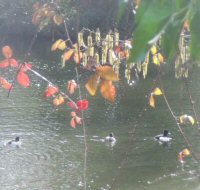
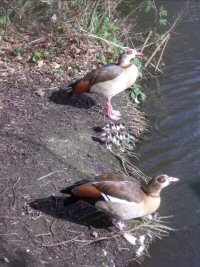
Above: Egyptian Geese with goslings
Middle: Tufted Ducks
Top: Little Egret
|
Nature Notes
Edwin Trout
In mid-January, EEG members reported the visit of a Barnacle Goose to Maiden Erlegh Lake, and a photo was posted on Facebook by way of confirmation. On the 4th February, a Little Egret could be seen perched on a fallen tree branch on the south side of the lake – a seldom-seen visitor to Maiden Erlegh. By late February there were three Tufted Ducks on the lake, three on 26th February and a pair still here on 12th March.
In the last issue we mentioned the swans and the short-lived Egyptian goslings. I am delighted to report a new brood has recently hatched, four being spotted on Friday 24th March. As for the swans, they have been less confined to the lake than the previous pair (whose tenure ended in late 2021). They have been seen airborne on a couple of occasions, flying off to the west in December and flying towards the lake from the north east in February. There have been times with no sightings on the lake and an occasion when one of the swans was evidently a juvenile. But whether they are the same birds as last year, there is a pair in residence, with all the appearance of selecting a nesting site and displaying the indicative aggressiveness to the Canada geese.
A garden sighting
Also picking up on the last Newsletter, Alice Ayers notes that Honey Fungus such as that shown on the front page has killed shrubs and a few trees in her garden. She adds an interesting sighting of her own:
“On two consecutive days this summer a break-off small group of starlings visited the garden. On the first day, not far from the kitchen window, 8 young starlings perched along the back of a garden bench were being fed from the bird feeders a short way from it by one starling. The following day there were 10, being fed by what looked more like a blackbird. I thought it was time to update my specs. I’d love to have taken a photo but was afraid of spooking them. However, not long afterwards a friend showed me a cutting from BBC Countryside or Wildlife”:
My friends were delighted to see a jackdaw chick being fed by a female blackbird in their Hertfordshire garden. This continued for four days, with a male blackbird occasionally helping out. Is it unusual?
In the UK, only cuckoos intentionally take advantage of another bird’s parental skills. In the case of the blackbird and the jackdaw, it is likely that the blackbird is in full breeding mode and feels compelled to feed the gaping jackdaw. It could be drawn in by the call or the bright yellow gape. The blackbird could have young of its own nearby, or could have lost chicks and has the urge to feed any bird gaping for food. Garden Survey
Sheila Crowson looks back at earlier records for March by our two garden surveyors, Gillian and Margaret:–
In March 2021 Gillian recorded two Redwings in back garden, a winter visitor, which the RSPB states rarely visits gardens and is the UK’s smallest thrush. More likely to be seen in fields and hedgerows.
In March 2021 Margaret recorded a green woodpecker on her lawn for ten minutes. They adore ants. Gillian was also visited on her lawn by a green woodpecker in both March 2021 and 2022. They are residents all year and are the largest of our three woodpeckers breeding in the UK.
|
|
EEG Programme
We list the Group’s forthcoming walks and talks – fuller details are on the EEG website.
2023 Programme
Walks and Talks
Please see the EEG website and public notice boards for further details and updates.
29 April
Dawn Chorus Walk around MENR led by Sally Wearing and Elaine Chartson of the Berkshire Ornithological Club.
Meet at 5.30am at the Interpretation Centre
4 June
Walk through the northern-most part of old Earley.
Start at 10am at Wokingham Waterside Centre
24 July
Broodbank Bug Hunt
10-11.30 and 12.30-14.00 in Maiden Erlegh Nature Reserve
5 August
Earley Green Fair.
September
Bat Walk
11 November
Walk taking in woods and meadows in the south of Lower Earley.
Start at 10am at Maiden Place car park.
22 December
Carols around the Lake
Contributors
Charlotte Allchin
Alice Ayers
Anne Booth
Elaine Butler
Bob Collis
Sheila Crowson
Edwin Trout
Elizabet Trout
Editor: 0118 966 3759
|
Toad Patrol in Priest Hill, Swallowfield Elaine Butler
Every year EEG member Elaine Butler organises a ‘toad patrol’ in Farley Hill, to ensure safe passage for toads crossing either of two roads to reach the pond in which they spawn each spring, and to record the numbers moving. Here she reports on this year’s migration.
The migration is over for another year. We started patrolling on 18th February and finished 37 days later. As with other years, we had someone patrolling every night, except six when it was too cold. Many thanks to everyone who patrolled this year. We moved 1118 toads and 3 frogs; and had 42 dead toads. There were 4 nights with over 100 (271, 216, 154 & 149); 12 days with between 10 and 100 toads; 6 days with fewer than 10 and 13 days with none. It makes a good record to send to FrogLife.
The Huge Earley Litter Pick
Bob Collis

Despite the poor weather Earley Town Council’s (ETC) Huge Earley Litter Pick (H.E.L.P.) on Sunday 26th March was a great success. The litter-pick leader Grahame Hawker reported that, thanks to 129 volunteers taking part in 11 groups a mountain of litter was collected, and it was a great example of the public sector, the voluntary sector and the commercial sector all working together. Special thanks go to all of the litter-pick leaders, the co-leaders, and to the Earley Adopt-a-Street Initiative (EASI) for loaning much of the equipment. Grahame was supported by ETC’s Max Brown with his health and safety planning and by Wokingham Borough Council (WBC) which supplied bags and disposed of the collected litter. Special mention goes to McDonald’s (see photo) which provided a fantastic crew who picked their local area. The litter-pick is supported by the Earley Environmental Group and EASI, both of which supplied litter-picking volunteers . Look out for the next Huge Earley Litter Pick in the spring of 2024.
Edited by Edwin A.R. Trout, Earley Environmental Group.
Printed for the Earley Environmental Group by Purco Print.
|
|
|